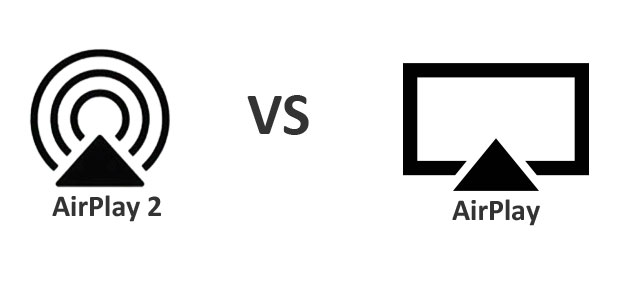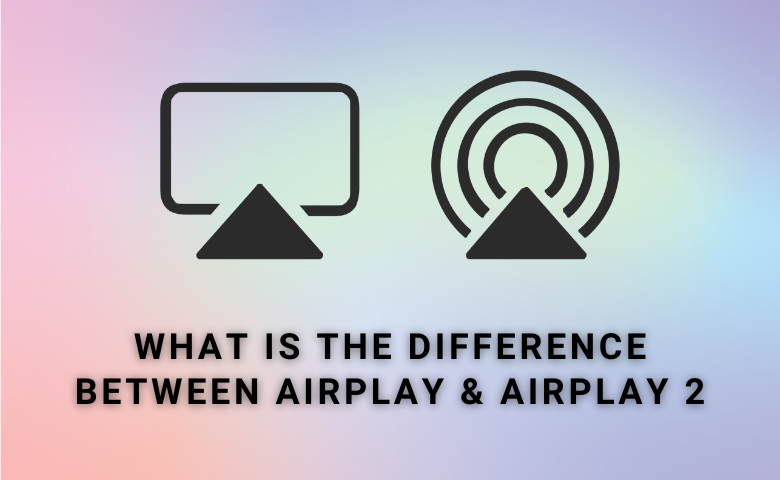AirPlay allows users to share media files from one Apple device to another using the same WiFi. AirPlay 2 is an updated protocol that supports multi-room audio, whereas AirPlay lacks support for connecting multiple devices. Therefore, you can play specific songs in different rooms by pairing AirPlay 2-compatible speakers. In this article, I have compared (AirPlay vs AirPlay 2) and shared some interesting facts you may have yet to hear of.

What is AirPlay?
AirPlay is a proprietary wireless protocol created by Apple Inc. and was released in 2010. It is an evolution of AirTunes, used only to listen to music. But AirPlay lets you stream audio, video, pictures, presentations, and more using an iPhone, iPad, iPod, and Mac. However, it won’t support multi-room streaming and HomePod pairing.
Some older devices are struggling to stream HD and UHD content via AirPlay. Though the 720p HD content looks good on an iPhone, it may not look better when you AirPlay to a 4K Smart TV.
What is AirPlay 2?
AirPlay 2 is the improvised version of AirPlay, released on 29 May 2018 as an iOS 11.4 update. They have fixed various bugs and technical glitches. It is compatible with smart TVs and speakers. It also has a device-to-device streaming protocol and supports multi-room audio streaming. You can control the playback using your device’s Control Center, the Home app, and Siri.
If you have two HomePods, you can use AirPlay 2 to get surround audio with stereo pairing. For this to work, you must use HomePod 1 as the left and HomePod 2 as the right speaker.
With AirPlay 2, you can create an “up next” playlist within the AirPlay 2-compatible app. Therefore, you can add your playlist to the mix. Though AirPlay 2 runs on your device, you can attend voice calls, play games, and surf the web without interrupting the streaming.
AirPlay-Compatible Devices
AirPlay is compatible with iPhones, iPads, Macs, Apple TVs, and PCs with iTunes, Apple TV [4K, HD, 2nd, 3rd, and 4th generation], Homepod, iPod Touch 2015, AirPort Express, and Apple Speakers.
But AirPlay 2 will be supported in iPhone 5S and newer versions, iPad [2017], iPad [ Air, Pro, Mini 2 and newer, Touch 2015-6th generation], Apple TV [2015, 4K running tvOS 11.4 or higher], and Homepod. Unfortunately, AirPlay doesn’t support devices which are manufactured before 2011. Some of the AirPlay 2-compatible devices are listed below.
- Air Conditioners and Heaters
- Air Purifiers
- Bridges
- Cameras
- Doorbells
- Fans
- Faucets
- Garage Doors
- Humidifiers
- Lights
- Locks
- Outlets
- Receivers
- Routers
- Security
- Sensors
- Speakers
- Sprinklers
- Switches
- Thermostats
- TVs
- Windows
Visit the official Apple website to know the complete devices supporting the AirPlay feature.
System Requirements
| AirPlay | AirPlay 2 | |
| What are the devices you can Stream from? | 1. iPhone, iPad, or iPod Touch with iOS version 4.2 or higher 2. Mac or PC with iTunes 3. Apple TV [4K series, HD ( 4th generation) ]. | 1. iPhone, iPad, iPod Touch with iOS 11.4 or later. 2. Apple TV [ 4K, HD-4th generation with tvOS 11.4 or later. 3. HomePod with iOS 11.4 or later. 4. Mac or PC with iTunes 12.8 or later or macOS Catalina. To stream video from: 1. iPhone, iPad, iPod Touch with iOS 12.3 or later. 2. Mac wit macOS Mojave 10.14.5 or later. |
| What are the devices you can stream to? | 1. Apple TV [4K, HD with tvOS 11.4 or later]. 2. HomePod with iOS 11.4 or later. 3. Smart TVs with Works with Apple AirPlay on the label. 4. Speakers connected to the Audio Out Port on AirPort Express 802.11- 2nd generation with the latest firmware update. 5. Receivers and Speakers will work with the Apple AirPlay label. | 1. Apple TV [4K, HD with tvOS 11.4 or later]. 2. HomePod with iOS 11.4 or later. 3. Smart TVs with Works with Apple AirPlay on the label. 4. Speakers connected to the Audio Out Port on AirPort Express 802.11- 2nd generation with the latest firmware update. 5. Receivers and Speakers will work with the Apple AirPlay label. |
Apple AirPlay vs AirPlay 2: Let’s Find the Best
First, we must thank brands like Sonos, Squeezebox, and Roku for bringing the Wireless Multiroom Audio feature. Check the table if you would like to know more about AirPlay vs AirPlay 2.
| AirPlay | AirPlay 2 |
|---|---|
| AirPlay is a one-to-one protocol | AirPlay 2 is a multi-stream protocol |
| However, it can group Multiple AirPlay 2 compatible devices, including HomePod and Apple TV, to play with sync using iOS, Siri, Homekit, and iTunes desktop. | High Bandwidth Wi-Fi-based audio with better capability than standard Bluetooth SBC. |
| You cannot receive a phone call on your iPhone while streaming. | However, you can receive the phone call on your iPhone while streaming, and it won’t interrupt the music. |
| It can play audio from iOS, macOS, and iTunes-supported desktops [ Windows & MacOS] | It is also capable of playing audio from iOS, macOS, and iTunes-supported desktops [MacOS and Windows] |
| It supports iTunes, Apple Music, Spotify/ Pandora, YouTube, Vevo, and web browsers. | It supports iTunes, Apple Music, Spotify/ Pandora/ Jio Tunes, YouTube, Netflix, Vevo, and web browsers. |
| It cannot group multiple AirPlay devices. | The option is to re-stream content from an AirPlay 2 device to a Non-AirPlay 2 devices to create a playback group. But it supports the specific manufacturer. |
| You might not control the content using the Siri voice assistant. | You can control AirPlay content using Siri voice assistant. |
| There is no option to re-stream the content. | The option is to re-stream content from an AirPlay 2 device to a Non-AirPlay 2 device to create a playback group. But it supports the specific manufacturer. |
| You may not stream the next video of your related content. | Instead, turn on the Up Next notification on the network of Apple devices. |
| It cannot be used with other Homekit devices to create scenes. | It can be used with other Homekit devices to create scenes. |
| It has low buffering. | It has high buffering. |
FAQ
AirPlay 2 uses the fastest Wi-Fi connection to stream video, audio, and more. As a result, the streaming quality will be better than using Bluetooth.
Apple did not mention any updates about the video quality. Therefore, there are no tests and proofs to justify AirPlay 2 video quality is better.
Yes. You can control speakers’ volume using the Apple Music and Home apps when connected via AirPlay 2.
Yes. AirPlay 2 supports lossless music up to 24-bit/48kHz, whereas AirPlay can support lossless music up to 16-bit/44.1kHz.

